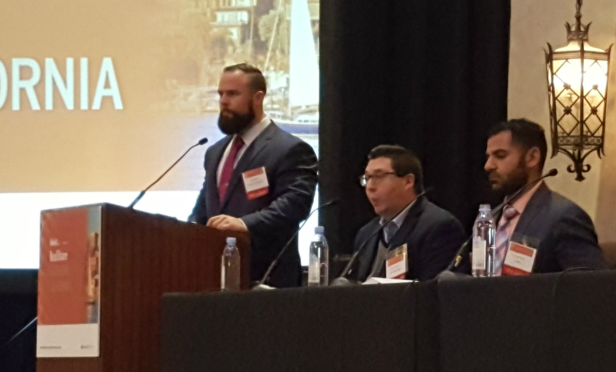
Rising interest rates were not a big concern of capital markets experts at RealShare Southern California. In fact, some experts are seeing an increase in floating rate debt and bridge lending activity. The Capital Markets Update: What's In Store for 2018 included Clark Briner, founder and president at Revere Capital; Michael Klein, co-Founder and CEO at Freedom Financial Funds; Bryan Shaffer, principal and managing director at George Smith Partners; and Zach Murphy, co-founder and managing director at Pender Capital, with moderator Marc Renard, managing director of capital markets at Cushman & Wakefield.
This year, there has been a “huge increase” in floating rate debt activity, according to Shaffer. However, on the permanent debt side, there hasn't been an increase, although some borrowers are looking to lock in rates before they go up. Despite the concern over rising rates, Shaffer says that rates likely will be in the 4% to 5% range this year. In addition to the boost in floating rate debt activity, Shaffer said that the bridge lending market has “exploded” as well. As a result, bridge rates have come down. “There are so many people in that bridge space,” he said. “It is a lot less expensive to buy something and remodel than to build from the ground up.”
For most of the speakers, rising interest rates were a non-issue. “We are not rate sensitive,” said Murphy, while Briner said there is no change on their end, adding, “We are getting a lot of feedback from borrowers about rates. As far as credit underwriting, we are not changing out box.” Klein said the industry is not over-levered, which bodes well for rising interest rates. However, he said, increasing rates will hurt clients. “I don't think that it is going to be the straw that breaks the camels back for our industry, but I do think it will be for our tenants,” he said on the panel. “Companies are very leveraged. We need to look at how it is impacting our tenants. That could be the catalyst, I don't know if it will be. I look at it from that point of view.”
On the equity side, Shaffer noted that the market has slowed, with joint venture equity being very conservative. “Six months to a year ago, there would have been lines to do it, but now there is fear in doing it,” he said. “We are seeing a move in that direction.” Foreign capital is another market that has dried up, largely because of China's outbound capital restrictions. In fact, some Chinese investors that were mid project are now looking for conventional financing to complete their deals, but the capital needed has been difficult to secure.
Looking ahead, the speakers showed some hesitation about the future. Klein said that some of the exuberance that he has seen in terms of sale prices and cap rates show that the cycle is “getting a little long in the tooth.” Shaffer, on the other hand, is confident in the real estate market; however, he said that usually at the end of a cycle it is one industry that causes a domino effect. “I think that it is going to be tech that has financial troubles,” he said.
© Touchpoint Markets, All Rights Reserved. Request academic re-use from www.copyright.com. All other uses, submit a request to [email protected]. For more inforrmation visit Asset & Logo Licensing.






